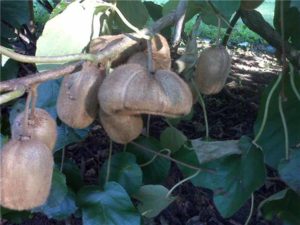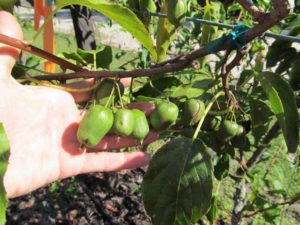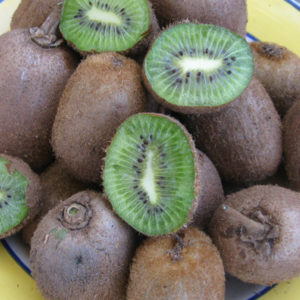[printfriendly]
Kiwis – Smooth or Fuzzy? You Decide!
 Decisions, decisions; to fuzz or not to fuzz that is the question. Well, frankly my dear, you can have them both! Originating in China, and by way of New Zealand, Kiwi came to the USA in 1904. However it wasn’t until the 1960-70’s that the fruit became popular.
Decisions, decisions; to fuzz or not to fuzz that is the question. Well, frankly my dear, you can have them both! Originating in China, and by way of New Zealand, Kiwi came to the USA in 1904. However it wasn’t until the 1960-70’s that the fruit became popular.
In your decision process, consider the different types of kiwis. Fuzzy Kiwis, Actinidia deliciosa, have large, fuzzy fruit with an inedible brown skin while the Hardy Kiwi, Actinidia arguta, have grape size fruit with smooth, green edible skin. Both types require a Male and a Female (except for Issai and Lone Star, two Hardy types that are self fertile). The Male is needed to pollinate the Female but only the Female will produce fruit – hmm, so even in the plant world it’s the same ;-). Typically one Male will pollinate 3-4 Females depending on the spacing of the trellised plants. Oh, yes, Kiwis are vines and big, heavy vines at that. You will need a good, sturdy support structure for the Kiwi vines to grow up onto and run across. In their native environment, Kiwi vines will climb up trees 25-100 feet! However with proper pruning techniques, you’ll be able to keep them to a manageable length and width.
 Besides lots of sun, Kiwis need well drained soils (they hate soggy or clay soils) and lots of water in the summer. They can grow in soils with a pH range of 5.0-6.5 and are heavy nitrogen feeder, so don’t be stingy with the fertilizer! Mulch with manure or hay but keep the mulch from touching the vine trunks to prevent crown rot.
Besides lots of sun, Kiwis need well drained soils (they hate soggy or clay soils) and lots of water in the summer. They can grow in soils with a pH range of 5.0-6.5 and are heavy nitrogen feeder, so don’t be stingy with the fertilizer! Mulch with manure or hay but keep the mulch from touching the vine trunks to prevent crown rot.
Once mature Fuzzy Kiwis can only tolerate 10F while Hardy Kiwis can withstand below freezing temperatures (-25F) when fully dormant for the winter. However any Kiwi plant must acclimate to the cold slowly and there can’t be any sudden drops in temperature or the trunks will split. Young vines are especially vulnerable to frosts and freezes. Temperatures below 30F in Spring can kill new leaves, shoots and ruin developing fruit. In Winter temperatures below 27F will cause trunk damage and below 10F will kill young vines and some older bearing vines.

So, what is the right Kiwi for your area? All Kiwi varieties have different winter dormancy or chill hour requirements. If the variety doesn’t get the needed chill hours it won’t flower and fruit. If it gets too many chill hours it will flower too soon and a late freeze will kill the flowers. To find out the chill hours in your area, AgroClimate has accumulated chill hour data ranging from North Carolina to Florida at http://agroclimate.org/tools/Chill-Hours-Calculator/
Hardy Kiwi varieties are the most versatile as they have been found to work in both high and low chill areas. Fuzzy Kiwi varieties, however, can vary from 100 to 800+ chill hours. Here are some varieties to consider.
Hardy Variety Sex Chill hours
|
Self Fertile (Male & Female Flowers) |
300-400 |
|
|
Self Fertile |
300 |
|
|
Male – needed for all Female varieties listed below |
300-400 |
|
|
Female |
300-400 |
|
|
Female |
300-400 |
|
|
Cordifolia |
Female |
300-400 |
|
Female |
300-400 |
** Lone Star is a chance seedling found fruiting in Panama City, FL. Different from Issai.
Fuzzy Variety Sex Chill hours
|
Female |
Estimated at 500 |
|
|
Male |
Estimated at 500 |
|
|
Female |
100-150 |
|
|
Male for Vincent |
100-150 |
|
|
Matua, Chico Early, Cal Chico No. 3 |
Males for Females listed below |
 |
|
Elmwood |
Female |
300 |
|
Haywood |
Female |
600-800 |
|
Saanichton 12 |
Female |
800+ |
 *Darlene and Barbas are chance seedling fuzzy kiwis planted and grown in the Tallahassee, FL area. The seeds came from a kiwi fruit bought at a local grocery store so we assume it’s either a California or New Zealand variety. For more info on kiwi varieties go to http://www.justfruitsandexotics.com/Kiwi.htm
*Darlene and Barbas are chance seedling fuzzy kiwis planted and grown in the Tallahassee, FL area. The seeds came from a kiwi fruit bought at a local grocery store so we assume it’s either a California or New Zealand variety. For more info on kiwi varieties go to http://www.justfruitsandexotics.com/Kiwi.htm
Kiwis don’t usually ripen on the vine. Harvest times can vary by region, anywhere from August to early November. Once you harvest the fruit, keep it indoors for at least a week before eating. Hardy Kiwi fruit will store for up to 2 months while Fuzzy Kiwi fruit can be stored from 3-6 months under the right conditions.
So if you’re looking for fruiting vines that will make you the envy of your neighbors and friend, go for the Kiwi!

